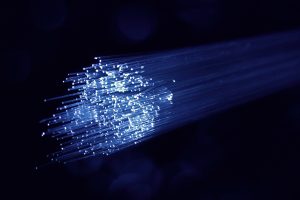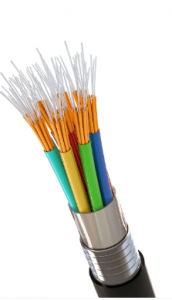The Shift
In the dynamic landscape of connectivity a shift is underway. As technology evolves, we are seeing the transition from traditional copper to fiber optics within many companies – it’s a transformative force shaping the way we stay connected. Fiber optic cables prove to be faster, more reliable, and provide efficient communication. There are several reasons behind this transition. So what are the benefits of fiber optics and how it impacts the future of our interconnected world?

Speed and Bandwidth:
- Fiber Optics: Boasting lightning-fast data transfer rates with the potential for terabit speeds.
- Copper: Gradually improving speeds but generally lagging behind fiber optics in terms of bandwidth.
The speed of fiber optics is paramount in the realm of connectivity due to its direct impact on data transmission efficiency and overall network performance. Unlike traditional copper cables, which rely on electrical signals, fiber optic cables utilize pulses of light to transmit data. This light-based transmission allows for data to travel at incredibly high speeds, approaching the velocity of light itself.
Distance and Reliability:
- Fiber Optic: Thrives in long-distance transmissions without signal degradation, ideal for expansive network setups.
- Copper: Limited by signal attenuation over longer distances, necessitating signal boosters or repeaters.
As companies are doing copper replacements in their network reliability is at the top of their list for why. Reliability is what customers want and expect and by ensuring a network has that means more growth and satisfaction.
Signal Interference and Quality:
- Fiber Optic: Immune to electromagnetic and radio-frequency interference, ensuring high-quality signal transmission.
- Copper: Susceptible to EMI and RFI, potentially compromising signal quality, especially in crowded electronic environments.

Along with reliability, quality is of the upmost importance to telecom companies wanting to provide exceptional service to their customers. Ensuring your network is up to the latest standards and proving quality service will set your company apart from the rest.
Security:
- Fiber Optic: Offers enhanced security as it doesn’t emit electromagnetic signals, making it more challenging to tap.
- Copper: Prone to eavesdropping due to electromagnetic emissions, posing potential security concerns.
Size, Weight, and Flexibility:
- Fiber Optic: Slim, lightweight, and flexible, allowing for easier installation and maneuverability.
- Copper: Sturdy and durable, albeit bulkier and less flexible, making installation in tight spaces more challenging.

Along with Fiber’s ease of install there are multiple options when installing fiber including pre-connectorized blown fiber options. Making install a breeze and leaving you with a lot of room for growth in your network. To learn more about blown fiber read CEA’s post Blown Fiber: Transforming The Future Of Network Infrastructure.
Installation and Maintenance:
- Fiber Optic: Requires careful handling during installation but has a lower susceptibility to wear and tear.
- Copper: Robust and easier to install in various environments but may be more prone to damage over time.
The long-lasting low maintenance of fiber is appealing to most companies. When building out a network, taking maintenance into consideration is a top priority.
Cost Considerations:
- Fiber Optic: Historically more expensive in terms of initial installation, but decreasing costs are making it more competitive.
- Copper: Generally more budget-friendly in terms of initial setup costs.
Costs on fiber and minor materials are decreasing as the market become more competitive for them. Working with a trusted and reliable source will not only help bring cost savings but ease to the whole process from start to finish, including continued support throughout your network build. CEA has been providing this type of support for more than 30 years and excited to see what the future holds for fiber optic networks as more and more customers make the change from copper to fiber.